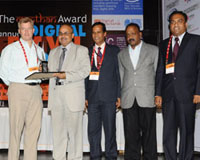e-Education & Learning, Winner 2012
 The institution for Open Distance Learning is using ICT as a major strategy towards reaching the unreached and providing the quality support to NIOS learners especially to people with a disability. The NIOS Online project has brought convenience to its learners and introduced user friendliness into the basic operations of NIOS in the area of admission, examination and accreditation and enhanced the quality of the support services to its learners. The NIOS has its own web portal www.nios.ac.in for dissemination of information and for providing online citizen centric services as a major initiative of good governance. The admission process in NIOS is 100% online due to which the content of the NIOS website is designed learner friendly, simple and accessible. The website provides complete information about NIOS with rich content and in the process the NIOS Online project has brought convenience to its learners and client group, transparency in the basic operations of NIOS in the area of admission, examination and accreditation and enhanced the quality of the support services to its learners.
The institution for Open Distance Learning is using ICT as a major strategy towards reaching the unreached and providing the quality support to NIOS learners especially to people with a disability. The NIOS Online project has brought convenience to its learners and introduced user friendliness into the basic operations of NIOS in the area of admission, examination and accreditation and enhanced the quality of the support services to its learners. The NIOS has its own web portal www.nios.ac.in for dissemination of information and for providing online citizen centric services as a major initiative of good governance. The admission process in NIOS is 100% online due to which the content of the NIOS website is designed learner friendly, simple and accessible. The website provides complete information about NIOS with rich content and in the process the NIOS Online project has brought convenience to its learners and client group, transparency in the basic operations of NIOS in the area of admission, examination and accreditation and enhanced the quality of the support services to its learners.
 The CLT e-Patashale Live online initiative was launched in January 2011 and provides teaching to rural schools without access to qualified teachers, especially those to teach science, for example math or English. The programs objective aims at acknowledging the fact that children in remote villages are excluded from access to high quality teaching due to the lack of qualified teachers in the majority of rural government schools. The program uses technology to substitute the real presence of teachers and connect qualified personal from the CLT Hub to many remote classrooms simultaneously. Since, these are live teaching sessions, as opposed to broadcast, the teachers can address problems in real time situations.The content used is localized,to map the learning styles of rural children, cost-effective, scalable and replicable.This mode of learning for the children is many-folded. The teacher is online and teaching lessons are prescribed by the Department of Education.The program connects kids across classrooms for collaborative learning; uses interesting multi-media content to make concepts more clear and uses the white board for additional explanations. Contextually ‘Distance Learning’ is used for higher education in India. But the strength of the initiative lies in the strong belief that the need of the day is to connect qualified teachers to rural kids all over the county.
The CLT e-Patashale Live online initiative was launched in January 2011 and provides teaching to rural schools without access to qualified teachers, especially those to teach science, for example math or English. The programs objective aims at acknowledging the fact that children in remote villages are excluded from access to high quality teaching due to the lack of qualified teachers in the majority of rural government schools. The program uses technology to substitute the real presence of teachers and connect qualified personal from the CLT Hub to many remote classrooms simultaneously. Since, these are live teaching sessions, as opposed to broadcast, the teachers can address problems in real time situations.The content used is localized,to map the learning styles of rural children, cost-effective, scalable and replicable.This mode of learning for the children is many-folded. The teacher is online and teaching lessons are prescribed by the Department of Education.The program connects kids across classrooms for collaborative learning; uses interesting multi-media content to make concepts more clear and uses the white board for additional explanations. Contextually ‘Distance Learning’ is used for higher education in India. But the strength of the initiative lies in the strong belief that the need of the day is to connect qualified teachers to rural kids all over the county.
